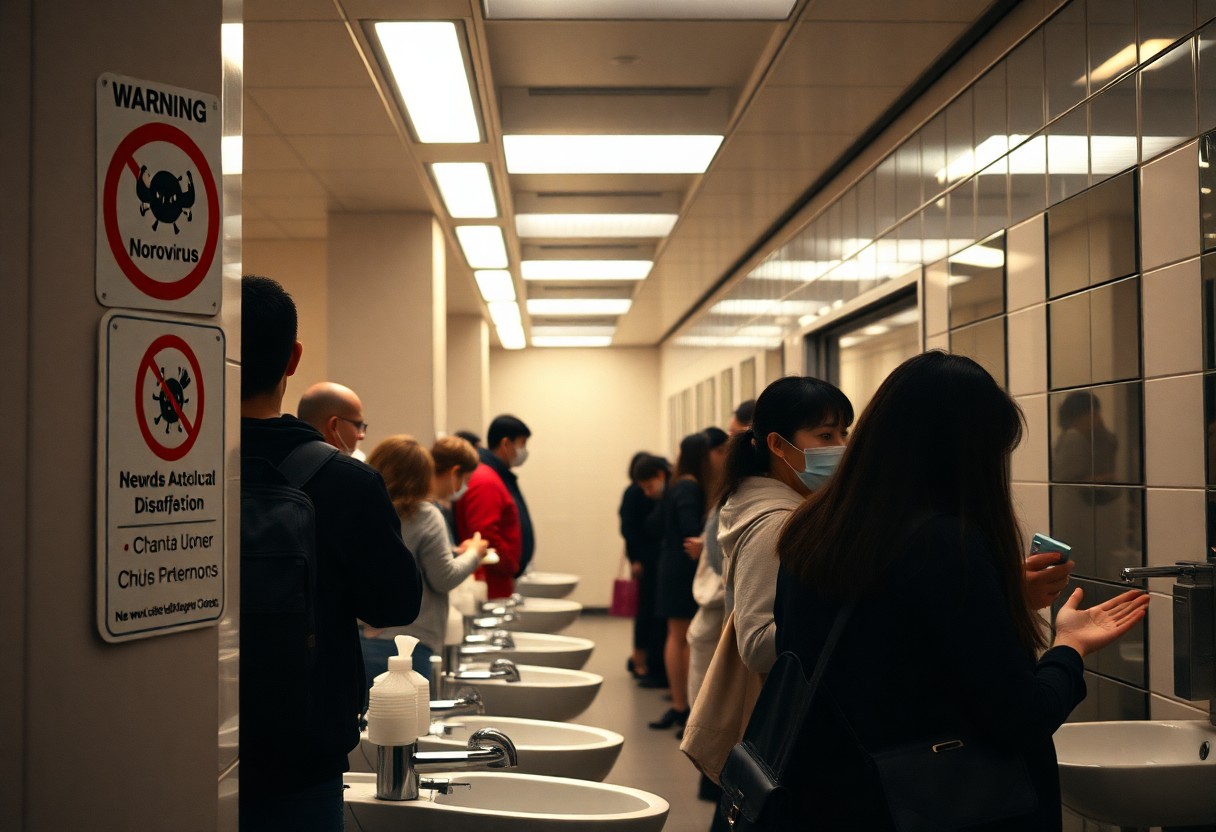Outbreaks of norovirus are causing widespread concern as the highly contagious stomach bug leads to increased cases of vomiting and diarrhea across the country. This virus often spreads through contaminated food and surfaces, making it vital for you to understand how to protect yourself and your loved ones. As winter months arrive, gatherings can contribute to the virus’s rapid transmission, so knowing the symptoms and prevention strategies is vital for staying healthy during this season.
Overview of Norovirus
The highly contagious norovirus is a leading cause of gastrointestinal illness worldwide, often manifesting as a sudden outbreak of vomiting and diarrhea. This virus, commonly referred to as the stomach bug, spreads easily through contaminated food and surfaces, particularly during the winter months when people gather in close quarters. With a rapid transmission rate, understanding norovirus is important for effective prevention and management during peak outbreak periods.
Characteristics of Norovirus
An important aspect of norovirus is its resilience. This virus can survive on various surfaces, remaining infectious for extended periods. It is often transmitted through contaminated food, with infected food workers serving as a significant source of outbreaks. Norovirus can spread rapidly in crowded environments, making schools, restaurants, and cruise ships common locations for infection.
Symptoms and Incubation Period
Behind a norovirus infection, symptoms develop quickly, usually within 12 to 48 hours after exposure. The onset is often abrupt, with the primary symptoms being nausea, vomiting, diarrhea, and stomach cramps. During this time, you may also experience low-grade fever or body aches, further contributing to your discomfort. These symptoms can last for 1 to 3 days, making it important to stay hydrated and seek medical advice when necessary.
But even though the symptoms may subside within a few days, it’s important to understand that you can continue spreading norovirus for up to two weeks after feeling better. This persistent contagiousness highlights the need for proper hygiene and care to minimize the virus’s spread, especially in communal settings where sharing food and close contact occur frequently.
Transmission and Risk Factors
While norovirus is highly contagious, understanding its transmission and risk factors can help you take preventive measures. Key factors contributing to the spread of norovirus include:
- Consuming contaminated food or water
- Close contact with infected individuals
- Touching surfaces or objects contaminated with the virus
- Improper hand hygiene, particularly in food preparation
Thou should prioritize hygiene practices to minimize risk.
How Norovirus Spreads
With rapid transmission capabilities, norovirus spreads mainly through contaminated food and surfaces. The virus can linger on hard surfaces for up to 12 hours and for as long as 12 days on soft surfaces like carpets. Unsuspecting food workers can easily transmit the virus when they handle food items without proper hygiene, contributing to widespread outbreaks.
High-Risk Settings
Around crowded places such as restaurants, schools, and cruise ships, the risk of norovirus transmission increases significantly. These environments often involve shared food and close interactions, making it easy for the virus to spread among individuals. With a rise in outbreaks, especially during winter months, being mindful of exposure in these settings is important.
Indeed, as social gatherings resume following pandemic restrictions, high-risk settings have become hotspots for norovirus outbreaks. In December 2024, 91 reported outbreaks across 14 states emphasized this concern. Whether you’re dining at a restaurant or attending a catered event, take extra precautions to safeguard your health. Ensuring good hand hygiene and being cautious about the food you consume can significantly reduce your risk of contracting norovirus.
Current Outbreak Trends
Some infectious disease experts are raising alarms about a surge in norovirus outbreaks this winter. With over 91 outbreaks reported across 14 states by the beginning of December 2024, you may notice that this highly contagious virus is spreading more than in previous years. This increase in cases can be attributed to the rise in social interactions as people gather in close quarters.
Recent Statistics and Reports
For the first week of December 2024, data shows a significant escalation in norovirus outbreaks, with 91 recorded compared to 69 from the week prior. These numbers indicate more than double the average seen during this time in recent years, highlighting a concerning trend that you should be aware of.
Seasonal Patterns of Infection
Current patterns indicate that norovirus infections typically rise during winter months as people are more confined indoors. This seasonal prevalence is not just a coincidence; it aligns with the cooler weather when respiratory viruses are also more common, amplifying the spread of gastrointestinal illnesses.
In addition to the general increase during winter, norovirus’s resilience on inanimate surfaces enhances its transmission during this season. With factors such as crowded venues and shared food preparations contributing to its spread, it’s imperative to take precautions. The overlap of social outings and the virus’s persistence creates an environment where outbreaks can flourish, requiring you, your family, and your community to remain vigilant.

Preventive Measures
Now, staying protected from norovirus requires vigilance in both hygiene and food handling. Regular handwashing with soap and water for at least 20 seconds, especially after using the toilet or before preparing meals, is vital to prevent the virus’s spread. Additionally, being mindful of interactions during gatherings, particularly during winter months when norovirus cases surge, can help reduce your risk of infection.
Hygiene Practices
By implementing strict hygiene practices, you can significantly decrease your chances of contracting norovirus. Always wash your hands thoroughly after using the restroom, changing diapers, or handling raw foods. Since norovirus can persist on inanimate surfaces, routinely disinfecting high-touch areas in your home is also advised.
Food Safety Guidelines
Among the key strategies to avoid norovirus outbreaks is adhering to robust food safety guidelines. When dining out or preparing meals at home, ensure that all fruits and vegetables are washed thoroughly and cooked foods are prepared in clean environments. This vigilance is especially important during winter months, as CDC data shows a spike in norovirus outbreaks around this time.
But keeping food safe goes beyond washing produce. Always use separate cutting boards for raw and ready-to-eat foods, and make sure to cook food to the appropriate temperatures. Avoid preparing meals if you are feeling unwell, and if you had a recent bout of norovirus, wait at least 48 hours after symptoms have stopped before returning to food handling tasks, as virus particles can linger longer.

Management and Treatment
Once again, norovirus outbreaks are causing widespread gastrointestinal distress, and understanding management strategies is vital. There is no specific antiviral treatment for norovirus, so the focus should be on symptom relief and hydration. Make sure to drink plenty of fluids to prevent dehydration, which is a common complication. You should also rest your body to aid recovery while avoiding solid foods until vomiting subsides. Proper hand hygiene and thorough cleaning of contaminated areas will help limit the spread of this highly contagious virus.
Dealing with Norovirus Symptoms
At the onset of norovirus symptoms, which include severe nausea and vomiting, your first priority should be to stay hydrated. Clear fluids like water, broth, and electrolyte replacements are effective for rehydrating your body. Once the vomiting eases, gradually introduce bland foods, such as toast or rice, to your diet. Avoid dairy, caffeine, and greasy meals initially, as they can aggravate your gastrointestinal distress.
When to Seek Medical Attention
Above all, it’s vital to know when to seek medical help. If you experience symptoms like severe dehydration, persistent vomiting, or blood in your stool, immediate medical care is necessary. In young children, elderly individuals, or those with weakened immune systems, these symptoms may lead to more serious complications. Your health and safety should always come first.
But in addition to the aforementioned symptoms, look out for signs such as extreme fatigue, decreased urination, and persistent dizziness. If you’re unable to keep any fluids down for more than 24 hours or if your symptoms last longer than a few days, it’s important to consult a healthcare professional. Quick action can help you avoid complications associated with dehydration, especially given that norovirus outbreaks have been significantly higher than average this season.
Public Health Impact
For you, understanding the public health impact of norovirus outbreaks is imperative. The Centers for Disease Control and Prevention (CDC) reported an alarming increase in cases, with 91 recorded outbreaks by early December 2024—more than double the previous average. This surge highlights the virus’s highly contagious nature, particularly during winter months, when gastrointestinal illnesses peak due to close contact among individuals.
Norovirus in Healthcare Settings
To mitigate the spread of norovirus in healthcare settings, strict hygiene protocols are crucial. Medical facilities must prioritize handwashing and disinfecting surfaces, especially in areas with high patient interaction. Infectious disease experts recommend that healthcare workers exercise caution and refrain from preparing food for others when experiencing symptoms.
Economic Consequences of Outbreaks
Public health officials emphasize the economic consequences of norovirus outbreaks, impacting not only healthcare costs but also the broader community. Businesses, particularly restaurants and catering services, face significant financial strain due to lost revenue and increased hygiene measures.
And as a reader, it’s important for you to be aware that the economic burden extends beyond immediate healthcare costs. The ripple effect of norovirus outbreaks can result in decreased consumer confidence and increased absenteeism in the workplace. In addition, restaurants may experience temporary closures or restrictions, ultimately diminishing their revenue. Understanding these impacts can underscore the importance of preventive measures to protect both health and economic stability.
Norovirus Outbreak: Understanding the Stomach Bug’s Widespread
As a reminder, during the current surge of norovirus cases in the U.S., you should take extra precautions to minimize the risk of infection. This highly contagious stomach bug often spreads through contaminated food and surfaces, so ensure you practice proper hand hygiene, avoid preparing food when sick, and keep your environment clean. By staying informed and following preventive measures, you can help protect yourself and others during this challenging season of illness.


